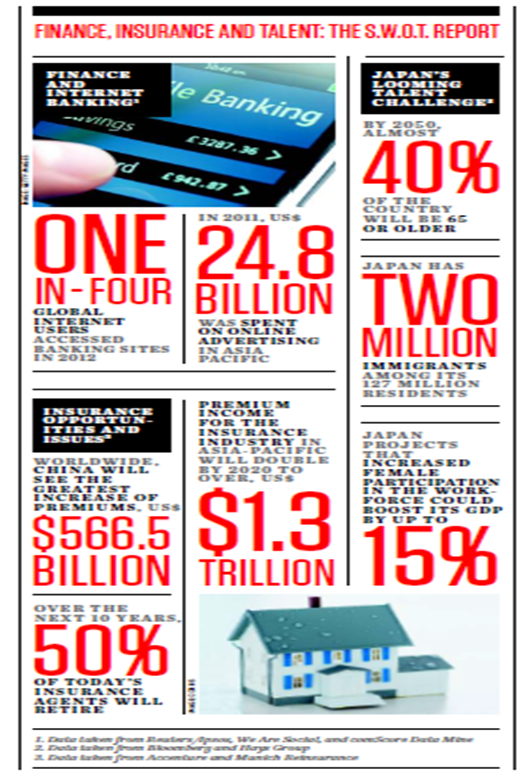Read Part I of this series, featuring Standard Chartered Singapore's Ray Ferguson, here.
Sankyu's Global Future
Next, we met up with Tomohiko Shinozaki, Sankyu’s Managing Director for Southeast Asia. He explained that Sankyu’s business model is a complex one. Theirs is a business-to-business operation, which focusses on providing comprehensive services to their corporate clients, including logistic support and the construction and maintenance of manufacturing plants. Sankyu’s fortunes are thus intricately interconnected with their clients’ – most of which are currently firms headquartered in Japan.
The challenge facing Sankyu is clear to Shinozaki. While Japan’s economy has shown recent signs of a turnaround, its long-term prospects remain grim. According to the Japan Center for Economic Research, Japan’s growth rates are projected to slow from an average of 0.8% this decade to about 0.4% in the next decade. Sankyu’s future success will depend on its ability to expand to high-growth markets like Southeast Asia.
While the recognition that Japanese firms need to globalise is not new, Shinozaki reflected that the speed of change today is unprecedented. He remarked that even in emerging markets like Thailand, wage inflation and currency appreciation are quickly eroding profit margins. Hence, it is imperative that Sankyu accelerates its globalisation agenda and targets new markets for growth. In his view, parts of Africa and the Middle East could become key areas for growth.
Sankyu’s success in globalisation will depend on its ability to attract and develop leaders capable of understanding and communicating with people of different cultures. Paradoxically, he noted that many Japanese find it more challenging to understand people from neighbouring Asian countries, than people from the US and the UK. Aspects of Western culture – in the form of novels, music or cinema – are widely available in Japan, while it is difficult to find literature by contemporary Indonesian or Thai authors.
As Sankyu ramps up its focus on emerging markets, its strategy has to evolve as well. For example, Shinozaki pointed out that the company could not compete on cost alone in markets like India. Sankyu has to emphasise its differentiators in terms of service quality and reliability, and be more creative in its talent-sourcing strategy. For example, Shinozaki thinks highly of the talent pool in the Philippines. Filipino talents are not just cost-competitive; they are also highly educated, proficient in English and not afraid to work in markets like the Middle East and Africa.
While Shinozaki is keen to hire more international talent, he also understands that it is important to hire foreigners who can understand and appreciate Sankyu’s Japanese heritage. For example, one of the company’s corporate mottos is “Jimon Jito” – which translates as the need to avoid self-centeredness and encourage empathetic thinking. Applicants who put their own career progress above the needs of others will not fit in well with the culture at Sankyu. Shinozaki believes the best way to assess cultural fit is to take the time to engage with prospective employees. There are no shortcuts.
At the same time, Shinozaki is also keen to help Sankyu’s Japanese managers become better global leaders. Japanese managers are notoriously reluctant to leave the home comforts of Japan, which undermines their ability to lead across borders. He believes the best way to develop Japanese global leaders is to do this in a gradual process – by first sending them to comfortable places like Singapore, before sending them to more challenging locations like the Middle East. In this way, Japanese managers can develop greater confidence to lead across cultures, while also developing a thirst for experiencing new cultures.
Sankyu’s future lies in globalisation. However, it is interesting to note that the company’s historical origins stem from globalisation as well. Sankyu’s founder – Seishichiro Nakamura – travelled to London as a young man in 1913. He became lost in the city, and reluctantly decided to trouble a local for directions. The Englishman he spoke with gave him detailed directions, wished him well and, before he left, said “thank you” to Nakamura. This left a profound impression on the young Japanese. This generous spirit of gratitude in helping is something that Nakamura wanted to capture and thus inspired the name “Sankyu” – which sounds like the English words “thank you”

Great Eastern's Constant Evolution
The last leader we met was Chris Wei, CEO of Great Eastern Life. Great Eastern is not just the largest life insurance company in Singapore; it is a company with more than 100 years of history. But talking with Wei, it becomes clear that the company currently has a transformative agenda, and sees the need for constant evolution to help ensure another 100 years of success.
One of the changes that Wei emphasised was the need to shift the company from being product focused, to being client-centric. By engaging clients more deeply, Great Eastern realised that most of them were not afraid of death. Instead, they were more worried about becoming critically ill or permanently disabled. This subtle insight has led Great Eastern to evolve from a “life insurance” company to a “life” company. The mission of the company is therefore to help their clients live healthier, longer and more fulfilling lives.
Wei argued that Great Eastern has to first internalise this shift if it hopes to help its clients achieve healthier lives. As such, the company encourages (and pays for) all employees to undertake biometric tests to track key health indicators like blood pressure and cholesterol. They have also created peer support mechanisms to encourage their employees to exercise. One example is the “21 Day Vertical Challenge”. Wei pointed out that it is difficult for one employee to have the discipline of walking up five flights of stairs every day. But if there was a group of employees walking up together, this becomes much easier. Why 21 days? Studies have shown that if people commit to a routine for at least three weeks, then there is a better chance for this habit to take root.
Looking ahead, Wei anticipates that the Internet can transform the way in which customers buy insurance products. He points out that 70% of Singapore consumers already do initial research online before talking with and buying from an agent face-to-face. In the future, he believes more and more customers will not only choose to search for insurance products and prices online, but also engage with advisors through digital forums (such as Skype) and possibly even make their insurance purchases online for simpler products.
As a response, Wei is already redirecting his marketing resources away from traditional media to online, social and mobile platforms. He pointed out that few customers look at a print or TV ad, and then decide to buy an insurance product. The Internet is different. It allows customers the opportunity to thoroughly research various products, as well as read feedback from other customers. Drawing a parallel, Wei said that for his personal travel, reading hotel reviews on the website TripAdvisor helps him pick the right hotel.
While some companies worry about the lack of control inherent in the Internet and social media, Wei has a different perspective. He argued that companies must prepare for both positive and negative comments online. “I don’t think our customers expect perfection,” said Wei, “what matters is how we handle complaints.” The insurance business is about trust, and companies that are transparent in their communication earn trust.
Visiting Great Eastern’s Facebook page illustrates this point – you will find both complimentary and critical comments. Great Eastern does not vet or block negative comments. Instead, they make an effort to acknowledge and apologise for any negative customer experiences.
The top business challenge facing the insurance industry in Asia, according to Wei, is the lack of talent. In a high-growth region, insurance companies have to compete against other financial services firms – which have been traditionally seen as more attractive employers. This war for talent is likely to heat up further. Wei highlighted that Southeast Asia is one of the most attractive regions globally, and markets like Indonesia, Malaysia and Vietnam are getting more attention from major international insurance companies.
Unlike many of its international competitors, Great Eastern is not keen to rely on expatriate talent. Wei pointed out that Great Eastern is an inherently Asian company and prides itself on understanding the nuances in Asian culture. This allows employees to better understand and serve their Asian customers. To Wei, the goal of being a great organisation relies on their ability to attract, retain and develop the best Asian talent.
There are reasons for optimism. Having lived in Hong Kong, Canada and the UK, Wei said that some of the brightest people he has worked with are from Asia. He is particularly impressed with the quality of the graduates that have gone through the Singapore education system. Wei also felt that Great Eastern has sufficient functional talent; what he is keen to develop is talent with broader managerial capabilities. He is also eager for his employees to be less deferential and communicate more openly. He joked that one of his achievements at Great Eastern was to convince people to address him simply as “Chris”, rather than “Mr Group CEO”.
In the three years that Wei has been at Great Eastern, the company has won a number of accolades. It was the only insurance company to be named one of Singapore’s top 10 brands (as rated by brand consultancy Brand Finance), and the highest rated insurance company for customer service in 2012 (as rated by SMU’s Institute of Service Excellence). However, Wei pointed out his delight at another achievement. When he checked Great Eastern’s Facebook account, he noticed that young people are now writing in to say, “Cool page! Can I send in my resume?” Great Eastern’s ability to address future challenges rests squarely on their ability to excite and attract the best young talent.
CEO Commonalities
We spoke to CEOs of three different companies, which have headquarters in different countries, operate in different industries and are experiencing different challenges. And yet, there are commonalities in how the CEOs are gearing up their organisation for the future. Each came across as an advocate of change. Each understands that he must help his organisation internalise the need for change and become personal ambassadors for transformation. While they conceded that the future is increasingly difficult to predict, they all agree on one thing: the best way to future-proof their organisation is to engage and develop in their most critical resource – their people.


